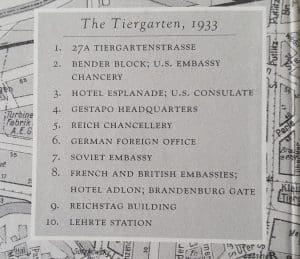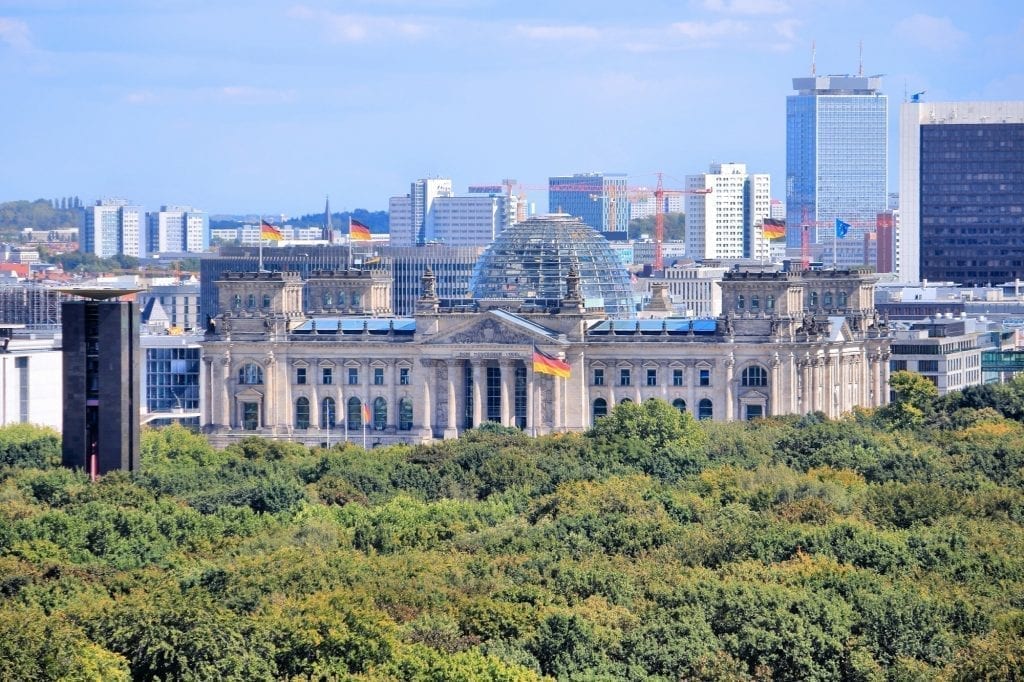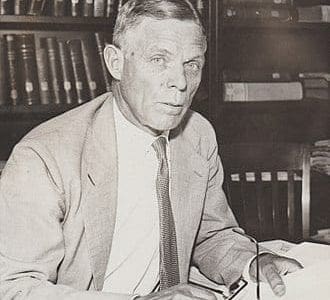 “In the Garden of Beasts” refers to the Tiergarten in Berlin (which translates to Animal Park or Beast Garden). Much of the book takes place around this beautiful park, once the hunting ground for the Great Elector Friedrich Wilhelm, the Grosse. In the 1930s, the Reichstag, the US Embassy, the Brandenburg Gate and Görings “city house” was nearby. This was Berlin’s backyard, and it was not unusual to see government officials, ambassadors and everyday people strolling or riding along the paths. Because it was the crossroads of Berlin, it’s an ideal backdrop to Erik Larson’s book on Germany in 1933-34.
“In the Garden of Beasts” refers to the Tiergarten in Berlin (which translates to Animal Park or Beast Garden). Much of the book takes place around this beautiful park, once the hunting ground for the Great Elector Friedrich Wilhelm, the Grosse. In the 1930s, the Reichstag, the US Embassy, the Brandenburg Gate and Görings “city house” was nearby. This was Berlin’s backyard, and it was not unusual to see government officials, ambassadors and everyday people strolling or riding along the paths. Because it was the crossroads of Berlin, it’s an ideal backdrop to Erik Larson’s book on Germany in 1933-34.
Order your copy of Erik Larson’s book here–>In the Garden of Beasts
In the Garden of Beasts

As a history geek, my friends and I will sometimes sit around playing the “if you could change one thing in history, what would it be?” Naturally, “kill Hitler before he gained power to prevent World War 2” is a popular one. Yet that notion is too simplistic, especially after reading “In the Garden of Beasts” by Erik Larson, and I think that there are so many other options that could have been taken. But then, the events of history are always clearer in hindsight. How could anyone know exactly what was about to happen?
However, looking back at Germany in the 1930s, we have to wonder if a better person in the job could have changed history. Is it possible for a United States ambassador to be present at a defining moment in world history and remain …oblivious? Apparently so, if “In the Garden of Beasts”, the history of William E. Dodd’s first 13 months in Germany, from June 1933 until July 1934, is anything to go by.

Who Was Willilam E Dodd?
 Dodd was chairman of the Department of History at the University of Chicago in 1933 when he was offered the position of ambassador to Germany. He had no real qualifications, other than some political connections with the Democratic Party and time spent as a graduate student at the University of Leipzig in the late 1890s. Certainly, he was without any experience in diplomacy or government service of any kind.
Dodd was chairman of the Department of History at the University of Chicago in 1933 when he was offered the position of ambassador to Germany. He had no real qualifications, other than some political connections with the Democratic Party and time spent as a graduate student at the University of Leipzig in the late 1890s. Certainly, he was without any experience in diplomacy or government service of any kind.
He was not Roosevelt’s first choice as ambassador, nor even his second. Several highly qualified men had declined the position. The President, though, was anxious to fill the slot so he could concentrate on the country’s economic problems. In the rush to get him to Berlin, Dodd was given no real instructions or guidance on American policy towards Germany. You could say he was thrown into the deep end with the sharks and weighed down with bricks.
William Dodd, an Ineffective Diplomat
Dodd arrived in Berlin accompanied by his wife, Martha (“Mattie”) and adult son and daughter, Bill and Martha. From the beginning, the new ambassador showed his unfitness for the position. He did not trust his staff, complained endlessly about his quarters at the embassy and made little effort to understand the political situation in his host country. He was so clueless, in fact, that he did not understand that his vague attempts to deal with what he viewed as the more “moderate” Nazis in the German government were undermining any help he could provide the victims of that regime, particularly German Jews.
Not that he seemed to particularly care. Dodd had that sort of casual, low-level anti-Semitism that was not uncommon in the 1930s, even complaining in his diary that the embassy personnel had too many “members of the ‘chosen race.’” Nor was he criticized by his superiors in the State Department for this attitude, for they were just as bad, if not worse.

As a diplomat, Ambassador Dodd showed only mushy weakness when dealing with the Nazi regime. In his personal meetings with Hitler, Dodd seemed more concerned with mollifying the German dictator than advancing American interests. Even in small-scale dealings with German provocation, such as when individual American citizens were abused by Nazis, his instincts seemed to trend towards getting the American victims out of the country rather than calling the German government to task.
To make it worse, the Germans didn’t respect Dodd. His disregard for political gamesmanship and protocol made him a joke. He was notoriously “cheap” at a time when ambassadors were expected to live a life of luxury and excess for show. He even drove his own aged Chevrolet that he brought in from the US (although some of his subordinates had their own chauffeurs!). Ever penny was pinched. Dispatches, were shortened by him personally to avoid extra charges. Worst of all, he left dinner parties EARLY to get a good night’s sleep, rather than stay and schmooze.
For some reason, Dodd chose to take along his adult children. His daughter’s attitudes and activities hardly helped Dodd’s position. Martha, in her early 20s, managed almost immediately upon their arrival in Berlin to enter into affairs with both the chief of the Gestapo and a Soviet secret agent, at the same time. (As an aside.. she also had affairs with with Thomas Wolfe and Carl Sandburg…) A much stronger anti-Semite than her father, Martha showed enthusiastic support for Nazism, even cheerfully giving the Hitler salute in public. (There is an odd story about her being introduced to Hitler, in the hopes that they would hit it off, and she would sooth the savage beast.) Only a few months later, she became bored with Nazism and began to actively work for the Soviets, even traveling to Russia. Yet, Ambassador Dodd did nothing to stop her, despite the terrible position in which she placed him and American interests.
In the Garden of Beasts by Erik Larson
The book is an interesting account of Germany in the lead-up to War. As he always does, Erik Larson makes history come to life. The book reads like a novel since he colors his story with interesting descriptions of what Hitler, Goebels, Göring and other historical characters were like beyond the usual text book basics. He makes them seem more like humans, and less like comic book villains. Larson also gives a foreshadowing of the camps (including a tour of Dachau by a representative of the Quakers, who decided the camps were quite orderly and “equipped for comfort”). The side stories included in “In the Garden of Beasts” make the novel quite engaging and make the history more than just words on a page or black and white video.

The Tiergarten, where Dodd took his daily strolls
Still, “In the Garden of Beasts” really is a depressing account of a failed ambassadorial mission and a dysfunctional family. It reads more like one of the more embarrassing “reality” television shows than a history of American-German relations at a pivotal time in history. It does make you wonder WHAT could have happened if the right man had been appointed to the job?
But then, looking at a historical time and place without considering what else was going on in the world is a mistake. Remember, in the 1930s, the USA was in the midst of the Great Depression, and seriously devoted to isolationism. The thought of taking in thousands of Jewish refugees was nuts! Hungry people looking for work? We have our own hungry people! (Naturally, there was an anti-Semitic streak that made these justifications easier to make.) And with so many men still suffering from the effects of WW1, the thought of getting embroiled in another European war was too much to bear. Then in 1930, the rains stopped… and in a short time the Dust Bowl sent thousands of Americans out on the road. Interfering with Germany could mean that all that all those Reichsmarks owed from World War 1 would stop flowing to US Banks. Other than money Americans, were not that interested in Europe’s problems.
History is set… we can’t change it. Still failing to learn from these events, allowing ourselves to identify the signs, might prevent something like this from ever happening again.
Order Your Copy of In the Garden of Beasts HERE
In the Garden of Beasts: Love, Terror, and an American Family in Hitler’s Berlin
|



